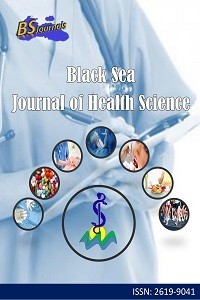The Morphometry of the Foot in Fetal Human Cadavers
Foot, Aborted fetus, Gestational age
The Morphometry of the Foot in Fetal Human Cadavers
Foot, Aborted fetus, Gestational age,
___
- Akman B, Güven M, Kocadal AO. 2017. Çocuklarda ayağın radyografik değerlendirmesi. TOTBID, 16: 389–398.
- Bek P. 2018. Ayak bileği ve ayak problemleri. Hipokrat Yayınevi, Ankara, Türkiye, 1. baskı, ss. 47-55.
- Canbaloğlu AE. 2019. Fetal kadavralarda ayak morfometrisi ve parametrelerin altın oranla ilişkisi. Yüksek Lisans Tezi, Süleyman Demirel Üniversitesi, Sağlık Bilimleri Enstitüsü, Isparta, Türkiye, ss. 3-14.
- Dere F. 2018. Anatomi atlası ve ders kitabı. Nobel Tıp Kitapevi, Adana, Türkiye, 8. baskı, ss. 1111.
- Dudek R.W. 2015. Embryology. İrez TEM, editor. İstanbul Tıp Kitabevi, İstanbul, Türkiye, 6. baskı, ss. 18-60.
- Gameraddin M, Salih S, Yousef M. 2014. Evaluation of gestational age with fetal foot length using ultrasonography. J Am Sci, 10(1): 5-7.
- Geldenhuys E, Coldrey J, Wright C, Nel D, Roberts D, Boyd TK, Odendaal H, Network, P. 2017. Fetal foot lenght at delivery as a tool for determining gestation lenght in non-macerated stillbirths. Int J Gynaecol Obstet, 138: 107-112.
- Hensinger R. 1992. Standarts and measurements: Fetus and neonate. In: Polin RA, Fox WW, editors. Fetal and Neonatal Physiology. WB Saunders Co, Philadelphia, USA, pp. 1687-1696.
- Joshi K, Marahatta SB, Karki S, Tamrakatr S. Shrestha NC. 2011. Fetal foot lenght and femur / foot lenght ratio: significant in nepalese context. NJR, 1: 15-22.
- Malas M, Desdicioğlu K, Cankara N, Evcil EH., Özgüner G. 2007. Fetal dönemde fetal yaşın belirlenmesi. SDÜ Tıp Fak Derg, 14: 20-24.
- Malas M, Doğan Ş, Evcil EH, Desdicioğlu K, Tağıl SM, Sulak O, Çetin E. 2005. Fetal dönemde üst ve alt ekstremite arasında büyüme oranı. SDÜ Tıp Fak Derg, 12: 1-8.
- Meirowitz N, Ananth CV, Smulian JC, Mclean DA, Guzman ER, Vintzileos AM. 2000. Foot length in fetuses with abnormal growth. J Ultrasound Med, 19: 201-205.
- Rhoades RA BD. 2017. Tıbbi fizyoloji: klinik tıbbın temelleri. Ağar EAM, Yıldırım M, editor. İstanbul Medikal Sağlık ve Yayıncılık Hiz. Tic. Ltd. Şti., 4. basım, ss. 840.
- Snell R. 2004. Clinical Anatomy. Lippincott Williams & Wilkins, Philadelphia, USA, pp. 551.
- Tuncer I. 2017. The development of the extremities of Turkish fetuses during the fetal period. IJRS, 70-73.
- Whitworth M, Bricker L, Mullan C. 2015. Ultrasound for fetal assessment in early pregnancy. CDSR, 7: CD007058.
- Wong H. 2017. A revisit of the fetal foot lenght and fetal measurements in early pregnancy sonography. IJWHC, 13: 199-204.
- Wyk L, Smith J. 2016. Postnatal foot lenght to determine gestational age: a pilot study. J Trop Pediatr, 62: 144-151.
- Xiao M, Luximon Y, Luximon A. 2012. Foot structure and anatomy. Gooneltilleke R, editor. CRC Press, Philadelphia, USA, pp. 21-35.
- Yüksel K, Günyeli I, Doğanay M, Uğur M, Mollamahmutoğlu L. 2006. Ultrasonographic assessment of the fetal foot length for gestational age estimation. GORM, 12: 27-29.
- Yayın Aralığı: Yılda 4 Sayı
- Başlangıç: 2018
- Yayıncı: Cem TIRINK
Emrullah KABINKARA, Ramazan KÖYLÜ, Nafis VURAL, Murat DUYAN
Effect of Balance Exercises on Balance and Walking a Patient with Ataxia Telangiectasia
Selma SOLGUN, Sevda CANBAY DURMAZ, Sibel ATEŞOĞLU KARABAŞ, Davut ÖZBAĞ
Potentially Inappropriate Medications In Geriatric Hemodialysis Patients
Kenan Evren ÖZTOP, Mahmud İSLAM, Enes ZAFER, Perihan VARIM, Hamad DHEİR
Sağlık Algısı ve Yaşam Doyumu Bağlamında Koronavirüs Anksiyetesi
Taner TUNÇ, Hasan Fehmi DEMİRCİ, Murat ŞAHİN
Muhammet Ali ORUÇ, Şule ÖZDEMİR
A Stress Management Tool in Nurses: Mindfulness- Based Stress Reduction
Hepatit B Virüsü: Yapı ve Patogenez
Hemşirelik Öğrencilerinin Duygu Düzenleme Becerilerinin Belirlenmesi
Ummahan Miray KANBER, Havva AKPINAR
Örgütsel Güven İle Örgütsel Sessizlik İlişkisi: Bir Üniversite Hastanesi Örneği
